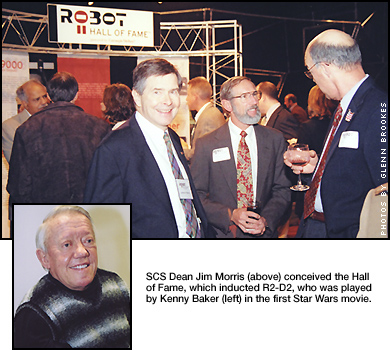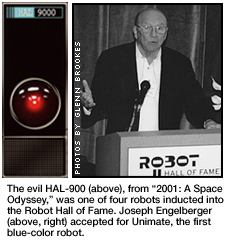|
|
||
|
|
|
Scientific, Fictional Robots Named to New Robot Hall of Fame
��
Carnegie Mellon has inducted four famous robots into its newly established Robot Hall of Fame, representing scientific breakthroughs and the realm of science fiction.
�
The first inductees, announced during a Nov. 10 ceremony at Pittsburgh's Carnegie Science Center, were NASA's Mars Pathfinder Microrover Flight Experiment (MFEX), better known as "Sojourner;" Unimate, the first industrial robot; R2-D2, the unforgettable droid from the "Star Wars" movie trilogy; and the evil HAL-9000 computer, the creation of science fiction writer and futurist Sir Arthur C. Clarke that was featured in the movie "2001: A Space Odyssey."
Carnegie Mellon has inducted four famous robots into its newly established Robot Hall of Fame, representing scientific breakthroughs and the realm of science fiction.
�
"This international first is a historic day for Pittsburgh and Carnegie Mellon, the world center for robotics research and education," said Carnegie Mellon President Jared L. Cohon. "This is where the Robot Hall of Fame belongs. This is a natural next step. We hope the Hall of Fame will become an international tourist attraction in Pittsburgh."
�
Chuck Thorpe, director of Carnegie Mellon's Robotics Institute, said the institute has been conducting research in many areas of robotics for nearly 25 years, helping to focus attention on a field that has great potential to help people.
�
The robots' creators or others close to them accepted certificates in their honor. Jacob R. Matijevic of NASA's Jet Propulsion Laboratory accepted for the Sojourner rover. Matijevic was responsible for the implementation, integration, delivery and eventual operation of Sojourner, which surpassed all expectations by traveling 800 feet of the Mars surface during 83 days of exploration in 1997.
�
Joseph F. Engelberger, known as "the father of robotics," accepted for Unimate, whose company Unimation installed the 4,000-pound robotic arm on a General Motors assembly line in 1961. Unimate, the first "blue collar robot," paved the way for the use of robotic technologies in industrial and manufacturing plants. Engleberger, who appeared with Unimate on The Tonight Show with Johnny Carson in the 1960s, praised Carnegie Mellon for its work in robotics and for creating the hall.
"Carnegie Mellon is the top research operation in robotics in the world today," he said.
�
"On behalf of George Lucas, R2-D2 and Lucasfilms, I thank you . . . and may the force be with you," Holliday said.
The Robot Hall of Fame was established earlier this year to honor noteworthy robots, both real and fictional, along with their creators in recognition of the increasing benefits robots are bringing to society.
��
One of the hall's unique features is that it inducts both real and fictional robots. "Science fiction is the first draft of science and technology. Science and science fiction go together quite well. Jules Verne took us to the moon before NASA did," Morris said.
��
"If robots will someday take over the world as some of my colleagues tell me, this puts us in good stead with them by creating this Hall of Fame," Morris added jokingly.
�
Morris put together a panel of 13 experts, drawn from organizations around the world, to choose the robots to be enshrined in the Hall of Fame. Each of them will serve a two-year term. The jury made its final selections from a field of 32 nominees via an international Web conference last September.
The criteria for choosing the robots depend on whether they are scientific, fictional or entertainment-oriented. Scientific robots must have served an actual or potentially useful function and demonstrated real skills in accomplishing the purpose for which they were created. Robots created to entertain must be functioning autonomous devices and have achieved a significant audience. Fictional robots should have achieved worldwide fame as fictional characters and helped to form our opinions about the function and value of all robots.
�
Next year's induction ceremony will be held in conjunction with the Robotics Institute's 25th anniversary celebration, Oct. 13-16, 2004.
Anne Watzman�
�
�
�
�
Top�
�
|
|
This Issue's Headlines || Carnegie Mellon News Home || Carnegie Mellon Home |
||

 Kathleen Holliday, director of special programs at Lucasfilms, accepted for R2-D2 on behalf of George Lucas, writer and director of "Star Wars." Also representing Lucas and R2-D2 were actor Kenny Baker, who played R2-D2 in the first Star Wars episode, and actor David Prowse, who played Darth Vader in the film.
Kathleen Holliday, director of special programs at Lucasfilms, accepted for R2-D2 on behalf of George Lucas, writer and director of "Star Wars." Also representing Lucas and R2-D2 were actor Kenny Baker, who played R2-D2 in the first Star Wars episode, and actor David Prowse, who played Darth Vader in the film.